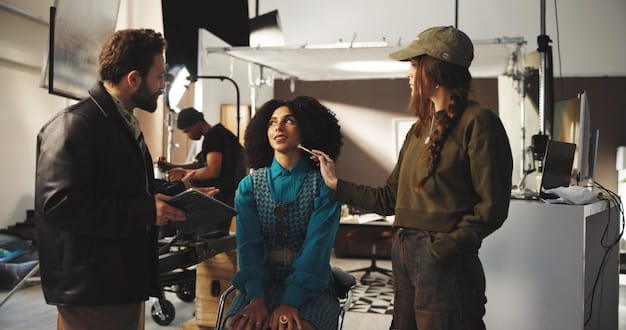Film Diversity Report: Analyzing Progress in the Last Year

Updated: Film Industry Diversity Report Released – What Progress Has Been Made in the Last Year? The latest film industry diversity report reveals incremental gains in representation, particularly for women and people of color in front of and behind the camera, but significant disparities persist, highlighting the need for continued systemic change and accountability.
The latest Updated: Film Industry Diversity Report Released – What Progress Has Been Made in the Last Year? paints a complex picture of Hollywood’s efforts to become more inclusive. While some strides have been made, the industry still faces significant challenges in achieving equitable representation across all levels.
Key Findings of the Latest Film Industry Diversity Report
Understanding the details of the report is crucial for anyone invested in the future of the film industry. The report offers a data-driven look at where the industry stands today, and what areas need the most attention.
This section breaks down the major results to help you understand what the latest data is telling us.
Representation in Front of the Camera
This section covers who we see on screen.
- Gender: Female representation has slightly increased, particularly in lead roles.
- Race/Ethnicity: Progress has been made in casting people of color, but true proportional representation is still lacking.
- LGBTQ+ Inclusion: More LGBTQ+ characters are present, but often still fall into stereotypical roles.
Behind-the-Scenes Diversity
What about the people who make movies happen?
- Directors: There’s been a slow but steady rise of female and minority directors.
- Writers: The writing room is still largely dominated by white males.
- Crew: Technical and production crews are more diverse, yet disparities remain.
The Film Industry Diversity report highlights both accomplishments and areas of stagnation. While some progress is visible in on-screen representation and the hiring of female and minority directors, behind-the-scenes roles and writers’ rooms still require major changes to achieve genuine diversity.

Areas Where Progress Has Been Noticeable
Let’s celebrate the wins! The report isn’t all bad news. Some areas show significant improvement, indicating that certain initiatives are working.
This section looks at the notable progress.
One of the most encouraging areas of progress is the increased representation of women in leading roles. Several high-profile films and television shows have featured female protagonists, demonstrating a shift towards narratives that center around female experiences.
Additionally, there have been some strides in the representation of people of color in front of the camera, with more actors from diverse backgrounds landing significant roles. This represents a positive step toward reflecting the diversity of the audience.
With initiatives such as mentorship programs and diversity targets, the needle is moving. However, the change must be sustained and broadened.
Persistent Challenges and Areas for Improvement
Despite progress, substantial gaps remain. There are still areas where the industry is falling short, and these require urgent attention.
This section details the ongoing obstacles to achieving true diversity.
Lack of Diversity in Writers’ Rooms
The racial and gender disparity in writers’ rooms remains a critical issue. Without diverse voices shaping the stories from the ground up, narratives may perpetuate stereotypes and lack authenticity.
Underrepresentation in Executive Roles
Decision-making power still resides predominantly with white males. Until more women and people of color are in executive positions, systemic change will be difficult to achieve.
Pay Disparity
Even when women and people of color secure roles, they often face a pay gap compared to their white male counterparts. Addressing this disparity is essential for achieving true equity.
While some advances have been made, the film industry continues to face persistent challenges, especially in writers’ rooms and executive roles. Addressing these disparities requires systemic changes such as inclusive hiring practices, mentorship programs, and a commitment to equal pay.
The Impact of Diversity Initiatives and Programs
Many organizations and studios have launched diversity initiatives. Are they working? What impact do these programs have on creating a more inclusive industry?
This section digs into impact.
Diversity initiatives can vary widely, from mentorships and training programs to diversity riders and inclusion policies. Ultimately, the effectiveness of these initiatives depends on their design, implementation, and the degree to which they are integrated into the overall culture of the organization.
Mentorship and Training Programs
- Programs to train and support talent from underrepresented groups can provide pathways into the industry.
- To maximize impact, programs must be structured to provide sustained support and clear career pathways.
Diversity Riders and Inclusion Policies
- Diversity riders in contracts can ensure a certain percentage of cast and crew members come from diverse backgrounds.
- Inclusion policies require studios to consider diversity at every stage of production.
Diversity policies are crucial for driving change in the film industry. However, their effectiveness is heavily dependent on their thorough implementation and integration into the overall culture of production companies and studios, ensuring they do more than just meet surface-level quotas.

The Role of Audience Demand and Social Media
Audience preferences can heavily influence industry choices. How much does audience demand drive diversity? And what role does social media play?
This section explores these powerful factors.
Audience demand for diverse content has grown in recent years, driven by a desire for stories that reflect a wider range of experiences and perspectives. Social media has amplified voices from marginalized communities, creating greater awareness of the need for inclusivity in film and television.
Fan campaigns and social media movements have successfully influenced casting decisions, challenged harmful stereotypes, and called for greater accountability from studios. These actions demonstrate that audience demand can be a powerful catalyst for change.
Social media allows fans to demand diversity and promote inclusive content. The economic pressure from audiences seeking diverse representation compels the industry to respond, ensuring that inclusive storytelling becomes both a moral and a financial imperative.
Looking Ahead: Future Trends and Predictions
What does the future of diversity in film look like? What upcoming trends can we anticipate, and what changes still need to happen to ensure equitable representation?
This section gazes into the crystal ball.
As the industry becomes more aware of the economic as well as social benefits of diversity, future trends are likely to include more inclusive storytelling, increased representation in key creative roles, and a focus on authenticity and cultural sensitivity. Furthermore, technology and new media platforms may play a significant role in democratizing content creation and distribution for underrepresented groups.
Predictions for the Future
- Increased focus on intersectionality, representing individuals with multiple marginalized identities.
- More authentic storytelling, with greater involvement from communities being represented.
Changes Needed for Equitable Representation
- Accountability and transparency in diversity metrics.
- Systemic changes to address biases in hiring and promotion practices.
The future of diversity in film involves not only increased representation but also fundamental shifts in storytelling, hiring practices, and accountability. As technology evolves, we can expect to see a more democratized landscape where diverse voices are amplified and celebrated.
| Key Point | Brief Description |
|---|---|
| 🎬 On-Screen Diversity | Increased representation of women and people of color in leading roles. |
| ✍️ Writers’ Room Gaps | Significant underrepresentation of diverse voices in writing roles remains. |
| 💰 Pay Disparity | Persistent gaps in pay between diverse actors and their counterparts. |
| 📢 Audience Influence | Audience demand and social media pressure promoting diverse narratives. |
Frequently Asked Questions
▼
The Film Industry Diversity Report is a study assessing representation in front of and behind the camera, highlighting progress and areas needing improvement.
▼
Key findings include increased representation of women in leading roles but persistent gaps in writers’ rooms and executive positions.
▼
Diversity initiatives vary in effectiveness, but well-designed and implemented programs can create pathways for underrepresented groups.
▼
Audience demand and social media have amplified calls for inclusion, compelling studios to respond with more diverse content.
▼
Future trends include increased focus on intersectionality, authentic storytelling, and greater accountability in diversity metrics.
Conclusion
The Updated: Film Industry Diversity Report Released – What Progress Has Been Made in the Last Year? underscores the mixed reality of Hollywood’s diversity efforts. While certain areas have seen advancement, significant challenges remain, particularly in behind-the-scenes roles and equal pay. Continued dedication to systemic change and accountability is imperative to foster a film industry that genuinely mirrors the diversity of its audience and the world.





